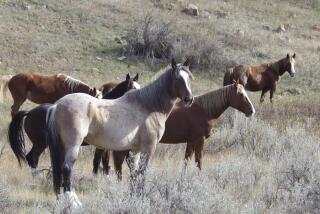N. Dakota Prairie May Be Next Oil Patch
- Share via
FARGO, N. D. — The Little Missouri National Grasslands, in the rugged Dakota territory where Theodore Roosevelt rode the range, could become the next frontier of oil development.
Two-thirds of the 20 million barrels of oil pumped on U.S. Forest Service lands in the last fiscal year came from 522 wells on the grasslands, said Louise Odegaard, the agency’s spokeswoman in Bismarck. The area includes more than 2 million acres of western North Dakota, from the oil-rich Williston Basin south into the Badlands and Theodore Roosevelt National Park.
Only a few leases have been issued on the grasslands in the past five years, but the Forest Service says that will change.
In a draft environmental impact statement on oil and gas leasing on the northern grasslands, the agency says that 500 new wells are expected to be developed within 10 years. The public has until June 1 to comment on the statement before the final report is issued.
The Bush Administration wants more public lands opened to oil and gas leasing, in part because of the Persian Gulf War and concerns about reliance on foreign fuel supplies.
Meanwhile, oil industry executives are growing impatient.
“Obviously, we want to do some leasing so we can drill on promising parts of land that have, frankly, been off-limits for too darn long,” said Lowell Ridgeway, executive director of the North Dakota Petroleum Council.
Environmentalists are bitterly disappointed with the proposal to open the 1.3 million-acre area to leasing. The remaining 800,000 acres were not part of the study.
“From what I have read of it, I think the Forest Service sold out to the oil and gas industry,” said Kirk Koepsel of the Sierra Club’s Northern Plains office. “We don’t see how the area is going to be protected.”
The grasslands support herds of bighorn sheep, bison and domestic cattle. Rare birds, such as the prairie falcon, golden eagle and ferruginous hawk, nest there.
Roosevelt was a young man when he ranched along the Little Missouri River in 1884. Indians hunted in the Little Missouri canyons for hundreds of years and archeologists have found signs of human habitation that span 20,000 years. The first European settlers arrived in the late 19th Century.
Intense farming and overgrazing rapidly depleted the fragile prairie, and many settlers abandoned barren claims to the Dust Bowl. The land reverted to the federal government in a random patchwork, making it difficult to develop a conservation policy for the region, the Forest Service says. The federal government owns a little more than half of the 2.1 million acres; the rest is private property.
While prohibiting drilling on the federal lands might seem the best way to protect the environment, the Forest Service takes the position that this would simply mean more drilling on adjacent private lands.
The environmental impact statement concludes: “The fewer wells established on federal minerals, the more likelihood there is for the federal . . . reserve to be drained by other wells and for the revenues to be lost by the federal government forever.”
Cattle ranchers generally support the idea of oil development, said Keith Winter of the McKenzie County Grazing Assn. in Watford City.
“If it’s done properly, oil development is of economic value to our area,” said Winter. “The impact on grazing can be minimized if the developer removes the oil, reseeds the area and locates roads in the right places.”
Mike McKenna, head of the North Dakota Game and Fish Department’s natural resources division, said that at least part of the area should be off-limits to leasing.
“At least that way, my kids will get the chance to see what undeveloped land looks like.”
More to Read
Sign up for Essential California
The most important California stories and recommendations in your inbox every morning.
You may occasionally receive promotional content from the Los Angeles Times.













